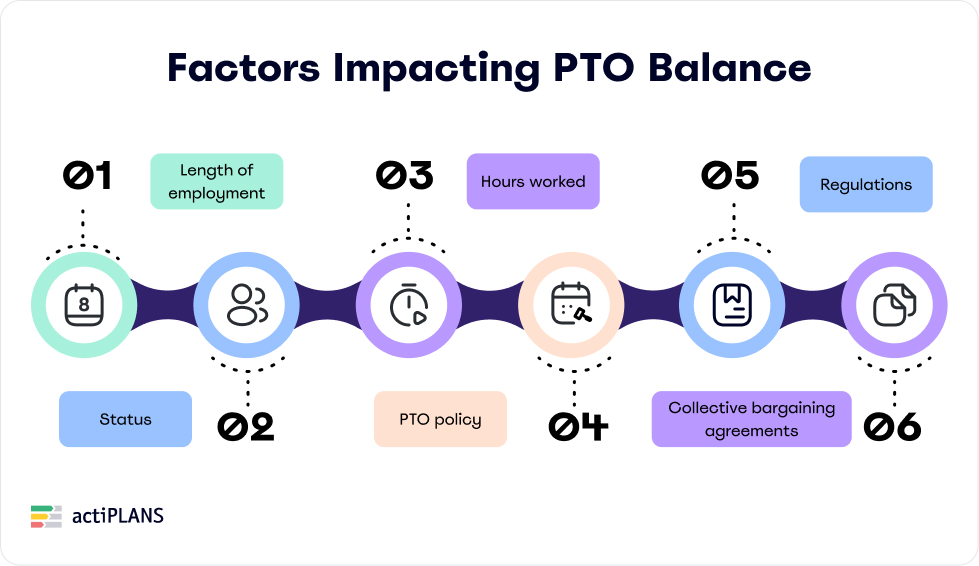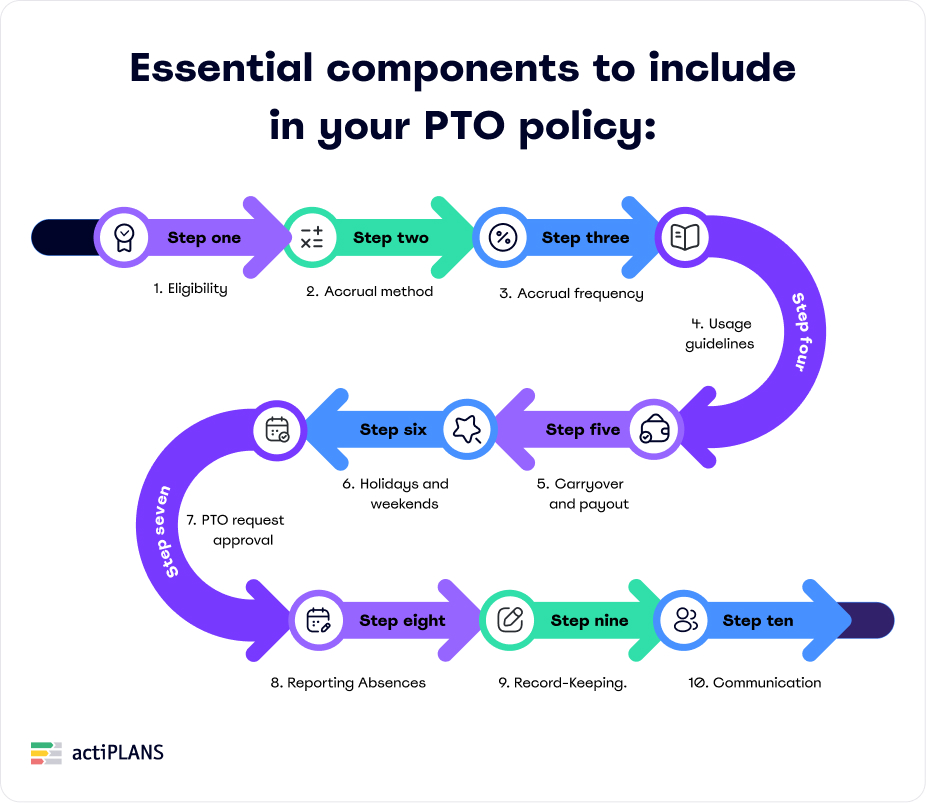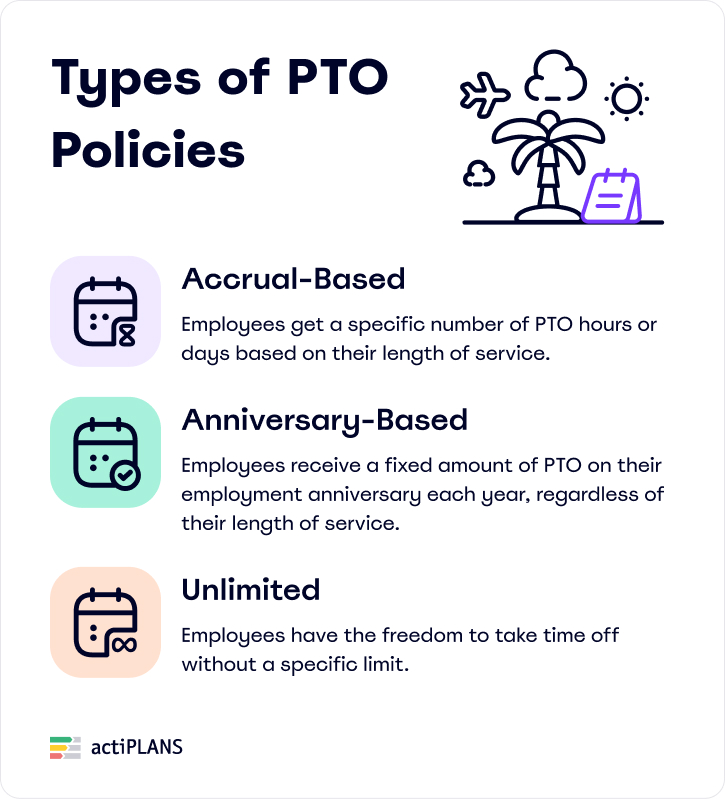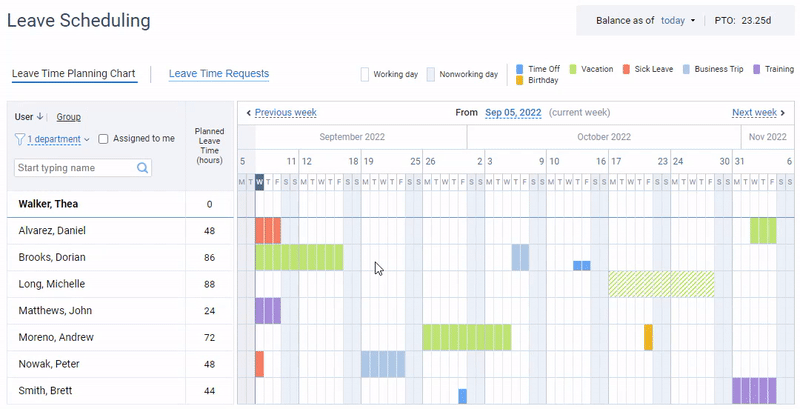Paid Time Off (PTO) is essential to any employment package. It allows employees to take time away from work and receive regular pay. However, PTO doesn’t just magically appear. Instead, it’s accumulated over time through a process known as PTO accrual. In this blog post, we’ll delve into what PTO accrual is and how to calculate it.
Understanding PTO Accrual
Simply put, PTO accrual is the process by which employees earn paid time off as they work.
The rate at which your PTO balance is accrued varies from company to company and may also depend on factors such as length of service, job position, or full-time versus part-time status. Let’s take a closer look at the most common ones.

- Length of employment. The longer employees work for a company, the more PTO they typically accrue. Policies may have tiers or increased accrual rates based on years of service.
- Hours Worked. PTO accrual can be based on the number of hours an employee works. Those who work more hours may accrue PTO faster than those who work fewer hours.
- Regulations. Labor laws in certain jurisdictions may mandate minimum PTO accrual rates or provide guidelines for PTO entitlements. Employers must ensure compliance with these legal requirements.
- Status/Classification. Full-time employees often accrue more PTO than part-time or temporary employees. Different employment classifications may have different accrual rates or eligibility criteria. In some cases, senior-level employees or those in certain positions might accrue PTO differently than other employees.
- Company policies. PTO accrual is influenced by the specific policies established by the company. These policies may vary based on industry practices, company size, and organizational culture.
- Collective bargaining agreements. In unionized environments, PTO accrual may be subject to negotiation and determined through collective bargaining agreements.
PTO Policies
All the details, rules, and procedures for employees to request and receive time off are outlined in a Paid Time Off (PTO) policy.

It typically includes details such as:
- Eligibility. The policy must clearly state who is qualified to receive PTO benefits. Typically, full-time employees are eligible for PTO, but some companies also provide it to part-time employees or contractors.
- Accrual method. This is the method by which employees accumulate PTO. It can be based on the number of hours, days, or weeks worked. For example, an employee might accrue one hour of PTO for every 30 hours worked.
- Accrual frequency. This determines how often PTO is accrued. It could be every pay period, monthly, or annually, etc.
- Usage guidelines. These are rules describing how and when PTO can be used. For example, some companies might require that PTO be used in half-day or full-day increments, or they might require that PTO be used within a specified timeframe after it’s accrued.
- Carryover and payout. The policy must also explain what happens to unused PTO at the end of the year. Some companies allow employees to carry over unused PTO to the following year, while others might pay out unused PTO at the end of the year.
- Holidays and weekends. The policy should specify whether holidays and weekends count as PTO days. Some companies might provide additional PTO for holidays, while others might count holidays as regular PTO days.
- PTO request approval. The policy should introduce the process by which employees request and receive approval for PTO. It typically involves submitting a request to a supervisor or HR department.
- Reporting absences record-keeping. The policy should outline how employees should report absences and how these absences will be recorded. This could involve an online system or a paper form.
- Communication. The policy should specify how and when changes to the PTO policy will be communicated to employees. It should also outline how employees can ask questions or get more information about the policy.
- Other components. Some PTO policies include provisions for unpaid time off, sick leave, family leave, and other types of absences. They might also specify what happens to accrued PTO when an employee leaves the company.
Types of PTO Policies
The type of PTO policy defines the guidelines set by a company regarding the way PTO time is accumulated.
Below, you’ll find the most common PTO policies used by organizations.

- Accrual-Based PTO Policy. Employees accumulate or “accrue” a certain amount of PTO hours for each hour, day or week they work. The accrual rate can vary depending on the company’s policy and an employee’s service length.
- Anniversary-based PTO Policy. Employees get a fixed amount of PTO on their employment date each year. PTO based on their length of service or employment anniversary with the company.
- Unlimited PTO Policy. Employees can take as much time off as they need, provided their work is not negatively affected. The goal is to promote a healthy work-life balance and increase employee satisfaction.
- Lump-Sum PTO Policy (“Front-Loaded” PTO policy). Employees have a set amount of PTO at the beginning of each year. Employees can use this time off throughout the year as they see fit.
- Use-It-Or-Lose-It PTO Policy. Employees are given a certain amount of PTO each year, but any unused time off does not roll over to the next year. This encourages employees to use their allotted vacation time.
- Earned Time Off Policy. Employees earn time off based on performance or meeting specific goals. It’s a way to reward high-performing employees with additional time off.
- Flexible PTO Policy. Employees can take time off when needed without accruing hours or waiting for a specific time of year. This can be particularly beneficial for companies that value work-life balance and trust their employees to manage their time.
- Bank-Type PTO Policy. Employees are given a “bank” of PTO hours at the beginning of the year. They can then “withdraw” from this bank whenever they need time off.
- Combined PTO Policy. This policy combines all types of time off (sick leave, vacation, personal days) into one pool that employees can use as they see fit. This gives employees more flexibility in how they use their time off.
- Rollover PTO Policy. Employees can carry over unused PTO up to a certain limit from one year to the next. This can be useful for employees who don’t use all of their PTO in a given year.
If you’re new to the subject, navigating the field of PTO policies could be pretty tricky. To make things a bit easier, we’ve prepared a big guide covering different elements of PTO policies and offering helpful suggestions on how to make yours work for your employees and your business as a whole
How to Calculate PTO Accrual
There are several ways to calculate PTO accrual. The specific method and rate for PTO accrual can vary greatly depending on the company policy described above and local labor laws. Here are some examples.
Hours worked method
As you remember, In this method, employees earn a certain amount of PTO for every hour they work.
Example. If an employee works 40 hours in a week and the PTO accrual rate is 0.05, then the employee would accrue 2 hours of PTO for that week (40 x 0.05 = 2).
Per pay period method
In this method, employees earn a fixed amount of PTO each pay period, regardless of the hours worked.
Example. If an employee receives bi-weekly pay and accrues 4 hours of PTO each pay period, then the employee would accrue 8 hours of PTO in a month (2 x 4 = 8).
Annual method
In this method, employees earn a fixed amount of PTO each year, which can be broken down into monthly or weekly accruals.
Example. If an employee is entitled to 120 hours of PTO annually and there are 24 pay periods in a year, then the employee would accrue 5 hours of PTO per pay period (120 / 24 = 5).
You can find more formulas and examples in this article.
However, calculating PTO accrual manually is a relic from the past. There are dozens of free online calculators like this one, not to mention the systems intended to simplify leave management in all respects.
Tools like actiPLANS streamline PTO accrual calculation, automate the process, ensure accuracy, promote transparency, and save time and effort for managers and HR professionals.
Here’s how actiPLANS can revolutionize your PTO accrual calculation and leave management processes.
- actiPLANS automates the entire procedure of PTO accrual calculation. It considers factors like employment dates, hours worked, and company policies to calculate each employee’s PTO balance accurately.
- actiPLANS allows you to tailor the system to your needs and policies. Whether you have different accrual rates for different employee levels, varying carryover policies, or unique holiday schedules, actiPLANS can accommodate it all.
- With actiPLANS, you can track PTO accruals in real time. This enables HR professionals and employees to view up-to-date PTO balances anytime, promoting transparency and reducing inquiries about PTO balances.
- actiPLANS provides detailed reports on PTO accruals and usage. These reports can be customized to show data for individual employees, departments, or the entire organization. This feature is handy for audits, planning, and ensuring compliance with labor laws.
- actiPLANS empowers employees by providing a self-service portal where they can view their PTO balances, request time off, and track their requests’ status.

Learn more about using actiPLANS to Smarten Up PTO Accrual.
Conclusion
Paid Time Off (PTO) is essential to employee benefits, but it’s easy to get overwhelmed between tracking accrual rates, managing carryovers, and ensuring compliance with company policies.
Moving from manual to automated PTO accrual calculation will greatly benefit your organization.
An automated system will perform all the calculations in seconds, freeing up valuable time for our HR team to focus on the strategic initiatives. It will also eliminate human error, ensuring all employees receive the correct amount of PTO.
Besides that, an automated system keeps all data in one place, making it easier to access and analyze when needed.
While there may be an initial investment to implement an automated system, the savings in time, resources, and potential compliance penalties make it a cost-effective solution in the long run.
So, don’t hesitate to streamline your PTO accrual calculation process today with actiPLANS and focus less on administrative tasks and more on strategic HR initiatives. Start your free trial today!



